Oral Hygiene Education: 20 Dental Healthcare Displays for Children
VerifiedAdded on 2020/03/16
|20
|3688
|78
Report
AI Summary
This report investigates the use of 20 dental healthcare displays designed to educate children about oral hygiene. It explores the importance of dental health, learning environment theories (Piaget, Bandura, and Vygotsky), and the effectiveness of interactive displays in promoting cognitive learning. The displays, incorporating colorful visuals, teach children about brushing techniques, healthy eating habits, and the impact of oral microbes. The report details the success of the displays, including children's ability to differentiate between healthy and unhealthy foods, and emphasizes the role of parental involvement. It concludes that such displays challenge traditional learning methods and promote active learning, encouraging children to adopt healthy lifestyles and understand the importance of regular dental checkups. The report includes appendices with time sample observations and feedback sheets to evaluate the displays' impact.
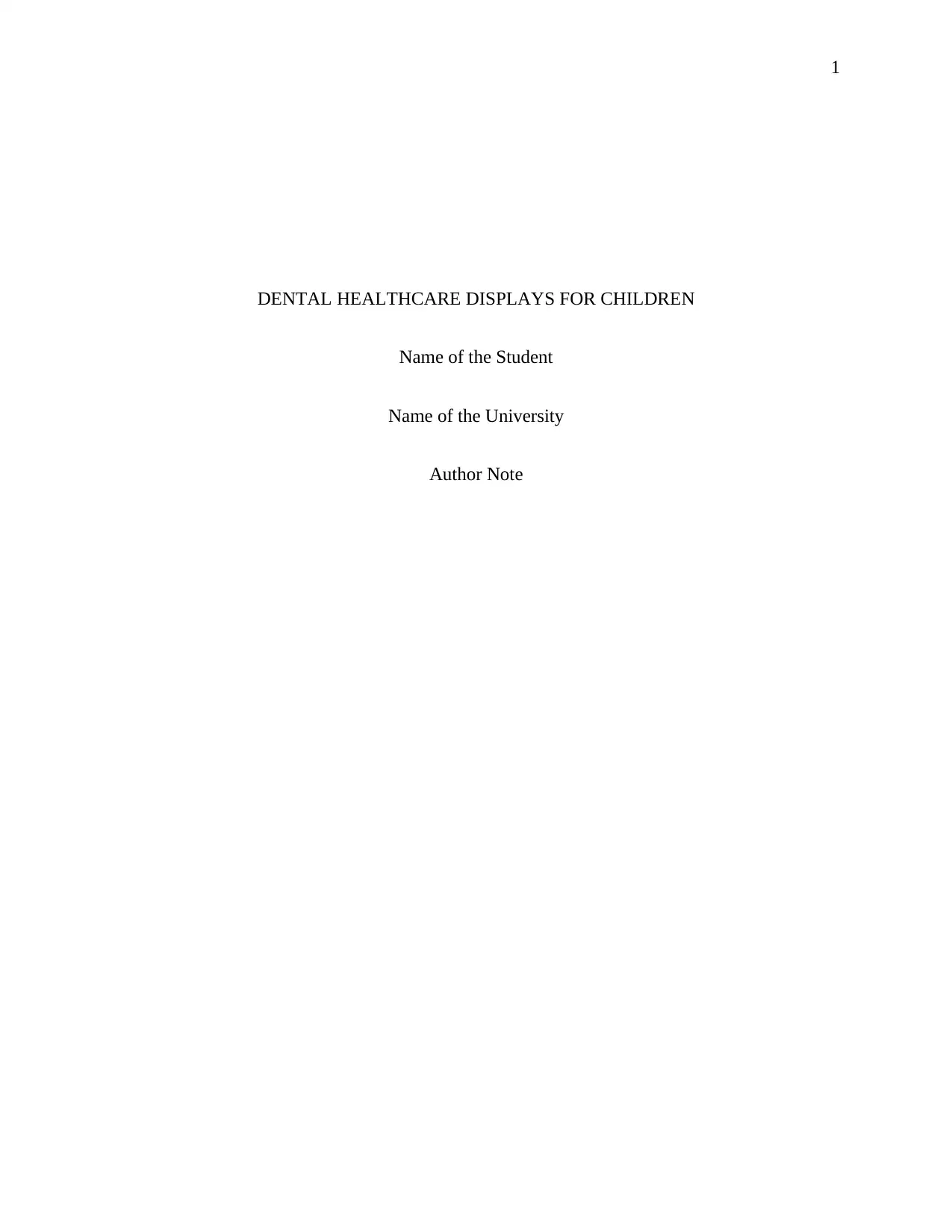
1
DENTAL HEALTHCARE DISPLAYS FOR CHILDREN
Name of the Student
Name of the University
Author Note
DENTAL HEALTHCARE DISPLAYS FOR CHILDREN
Name of the Student
Name of the University
Author Note
Paraphrase This Document
Need a fresh take? Get an instant paraphrase of this document with our AI Paraphraser
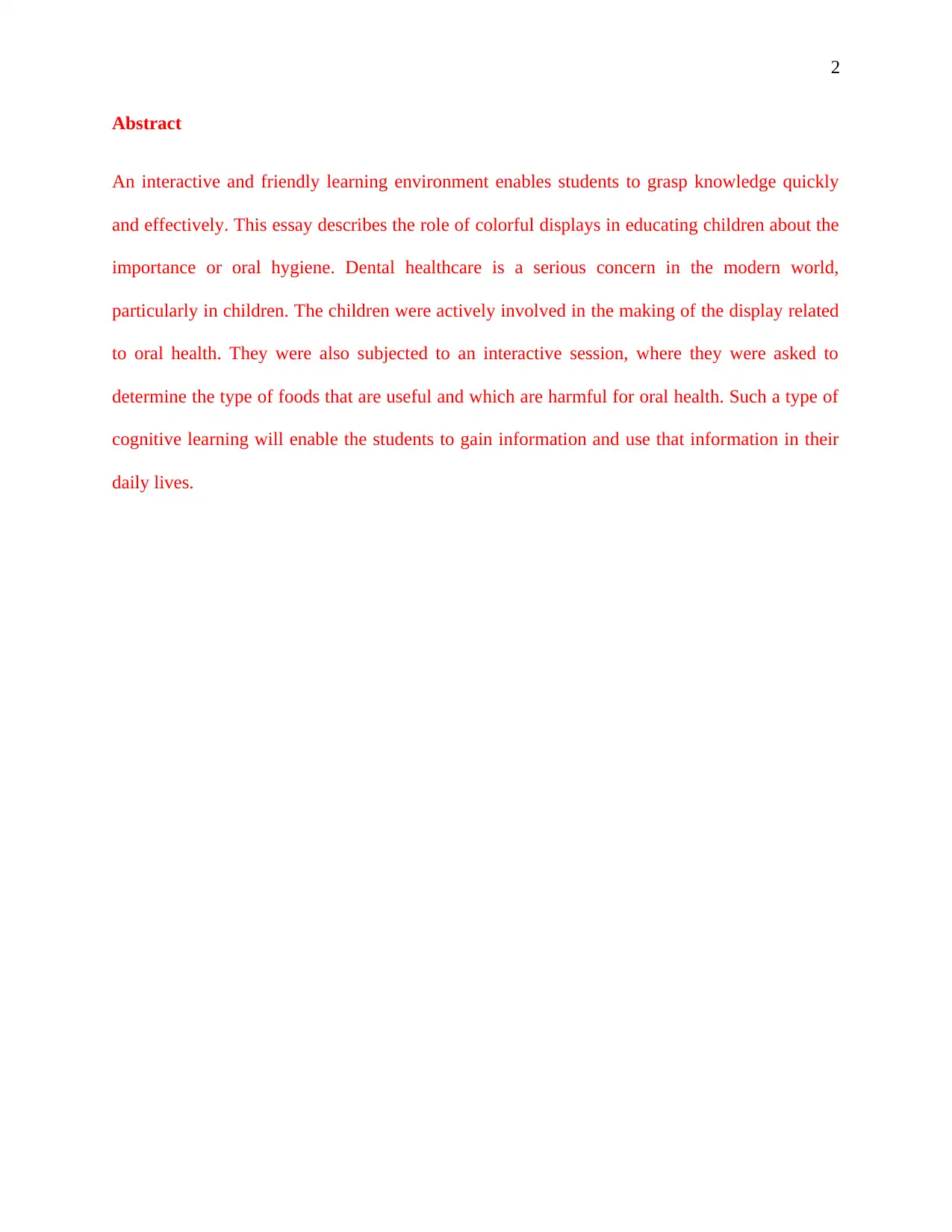
2
Abstract
An interactive and friendly learning environment enables students to grasp knowledge quickly
and effectively. This essay describes the role of colorful displays in educating children about the
importance or oral hygiene. Dental healthcare is a serious concern in the modern world,
particularly in children. The children were actively involved in the making of the display related
to oral health. They were also subjected to an interactive session, where they were asked to
determine the type of foods that are useful and which are harmful for oral health. Such a type of
cognitive learning will enable the students to gain information and use that information in their
daily lives.
Abstract
An interactive and friendly learning environment enables students to grasp knowledge quickly
and effectively. This essay describes the role of colorful displays in educating children about the
importance or oral hygiene. Dental healthcare is a serious concern in the modern world,
particularly in children. The children were actively involved in the making of the display related
to oral health. They were also subjected to an interactive session, where they were asked to
determine the type of foods that are useful and which are harmful for oral health. Such a type of
cognitive learning will enable the students to gain information and use that information in their
daily lives.
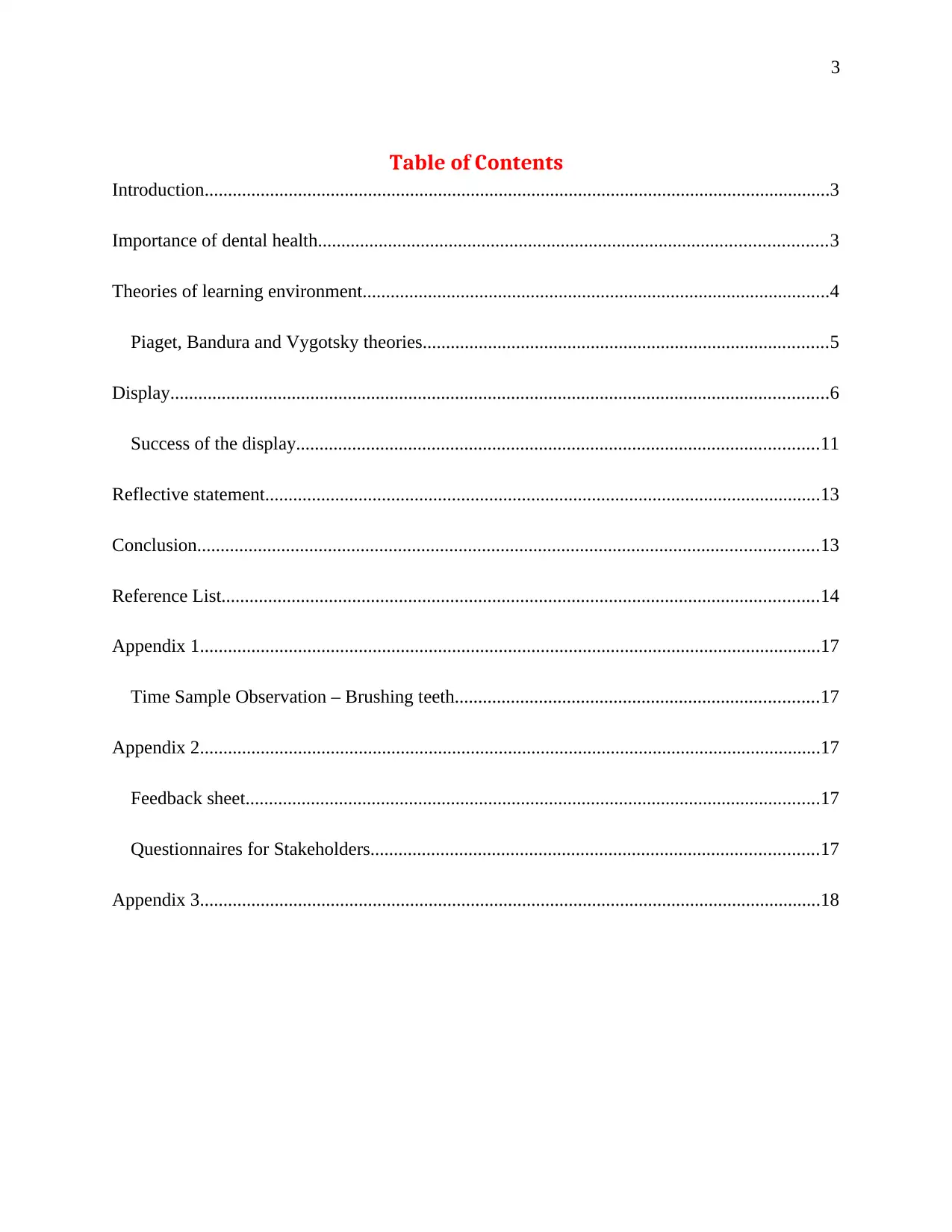
3
Table of Contents
Introduction......................................................................................................................................3
Importance of dental health.............................................................................................................3
Theories of learning environment....................................................................................................4
Piaget, Bandura and Vygotsky theories.......................................................................................5
Display.............................................................................................................................................6
Success of the display................................................................................................................11
Reflective statement.......................................................................................................................13
Conclusion.....................................................................................................................................13
Reference List................................................................................................................................14
Appendix 1.....................................................................................................................................17
Time Sample Observation – Brushing teeth..............................................................................17
Appendix 2.....................................................................................................................................17
Feedback sheet...........................................................................................................................17
Questionnaires for Stakeholders................................................................................................17
Appendix 3.....................................................................................................................................18
Table of Contents
Introduction......................................................................................................................................3
Importance of dental health.............................................................................................................3
Theories of learning environment....................................................................................................4
Piaget, Bandura and Vygotsky theories.......................................................................................5
Display.............................................................................................................................................6
Success of the display................................................................................................................11
Reflective statement.......................................................................................................................13
Conclusion.....................................................................................................................................13
Reference List................................................................................................................................14
Appendix 1.....................................................................................................................................17
Time Sample Observation – Brushing teeth..............................................................................17
Appendix 2.....................................................................................................................................17
Feedback sheet...........................................................................................................................17
Questionnaires for Stakeholders................................................................................................17
Appendix 3.....................................................................................................................................18
⊘ This is a preview!⊘
Do you want full access?
Subscribe today to unlock all pages.

Trusted by 1+ million students worldwide
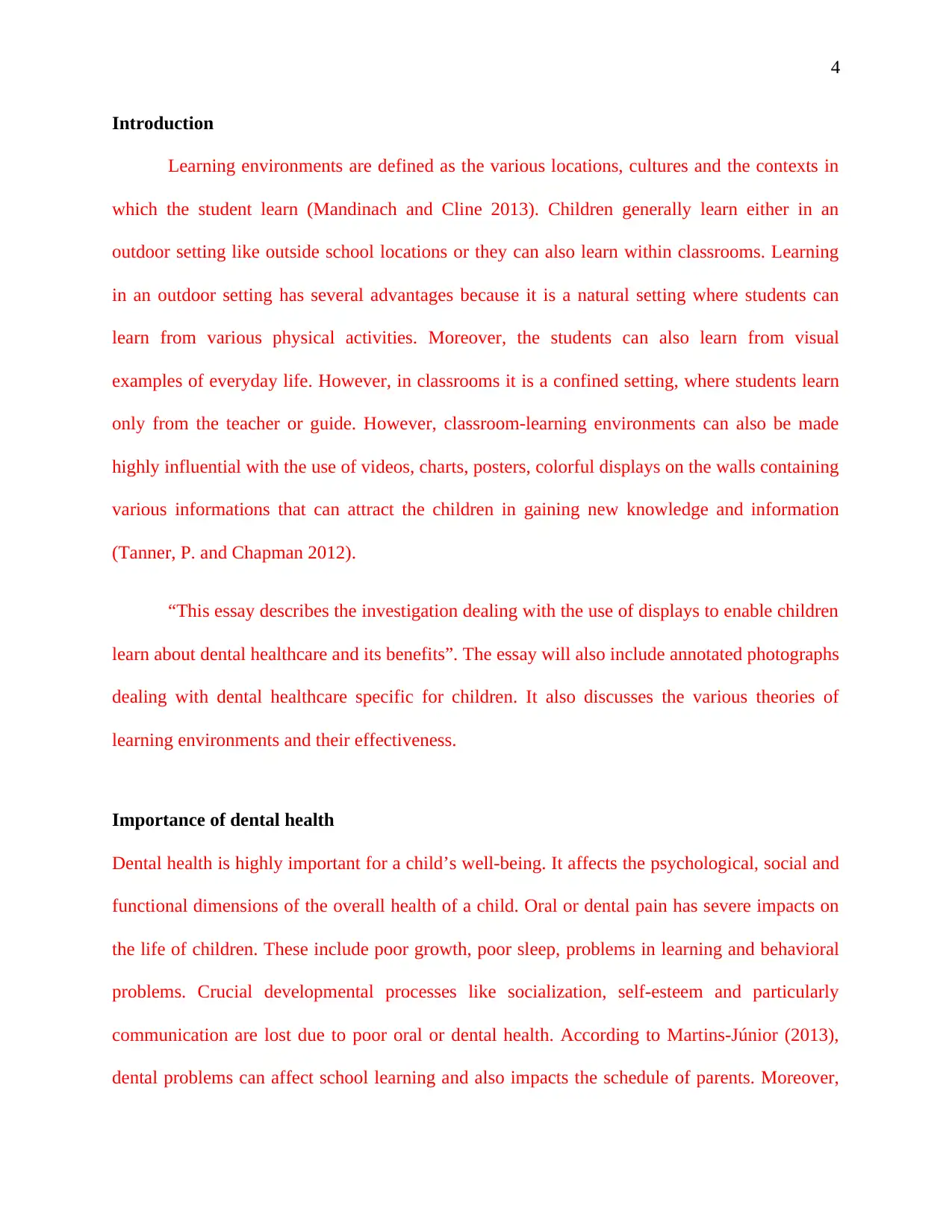
4
Introduction
Learning environments are defined as the various locations, cultures and the contexts in
which the student learn (Mandinach and Cline 2013). Children generally learn either in an
outdoor setting like outside school locations or they can also learn within classrooms. Learning
in an outdoor setting has several advantages because it is a natural setting where students can
learn from various physical activities. Moreover, the students can also learn from visual
examples of everyday life. However, in classrooms it is a confined setting, where students learn
only from the teacher or guide. However, classroom-learning environments can also be made
highly influential with the use of videos, charts, posters, colorful displays on the walls containing
various informations that can attract the children in gaining new knowledge and information
(Tanner, P. and Chapman 2012).
“This essay describes the investigation dealing with the use of displays to enable children
learn about dental healthcare and its benefits”. The essay will also include annotated photographs
dealing with dental healthcare specific for children. It also discusses the various theories of
learning environments and their effectiveness.
Importance of dental health
Dental health is highly important for a child’s well-being. It affects the psychological, social and
functional dimensions of the overall health of a child. Oral or dental pain has severe impacts on
the life of children. These include poor growth, poor sleep, problems in learning and behavioral
problems. Crucial developmental processes like socialization, self-esteem and particularly
communication are lost due to poor oral or dental health. According to Martins-Júnior (2013),
dental problems can affect school learning and also impacts the schedule of parents. Moreover,
Introduction
Learning environments are defined as the various locations, cultures and the contexts in
which the student learn (Mandinach and Cline 2013). Children generally learn either in an
outdoor setting like outside school locations or they can also learn within classrooms. Learning
in an outdoor setting has several advantages because it is a natural setting where students can
learn from various physical activities. Moreover, the students can also learn from visual
examples of everyday life. However, in classrooms it is a confined setting, where students learn
only from the teacher or guide. However, classroom-learning environments can also be made
highly influential with the use of videos, charts, posters, colorful displays on the walls containing
various informations that can attract the children in gaining new knowledge and information
(Tanner, P. and Chapman 2012).
“This essay describes the investigation dealing with the use of displays to enable children
learn about dental healthcare and its benefits”. The essay will also include annotated photographs
dealing with dental healthcare specific for children. It also discusses the various theories of
learning environments and their effectiveness.
Importance of dental health
Dental health is highly important for a child’s well-being. It affects the psychological, social and
functional dimensions of the overall health of a child. Oral or dental pain has severe impacts on
the life of children. These include poor growth, poor sleep, problems in learning and behavioral
problems. Crucial developmental processes like socialization, self-esteem and particularly
communication are lost due to poor oral or dental health. According to Martins-Júnior (2013),
dental problems can affect school learning and also impacts the schedule of parents. Moreover,
Paraphrase This Document
Need a fresh take? Get an instant paraphrase of this document with our AI Paraphraser
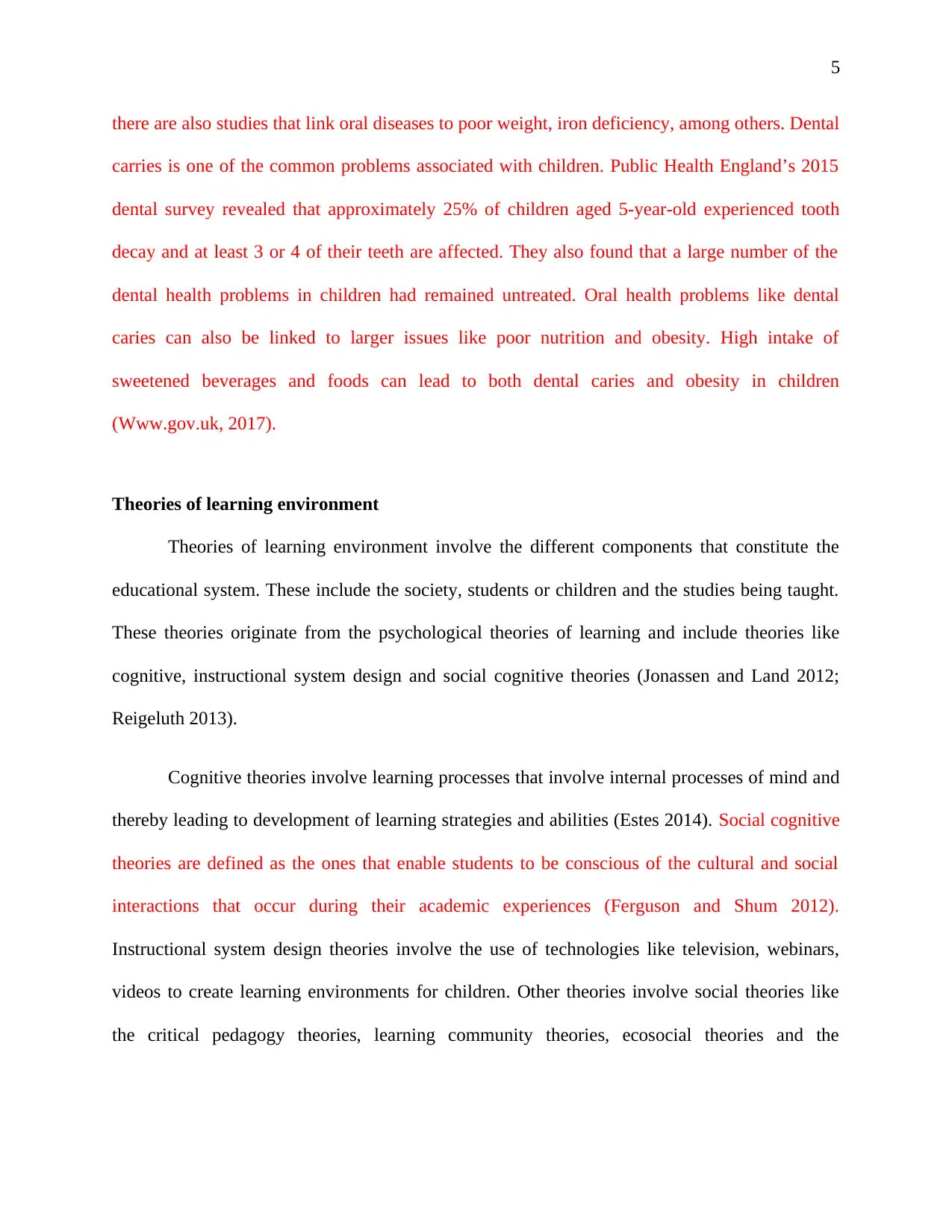
5
there are also studies that link oral diseases to poor weight, iron deficiency, among others. Dental
carries is one of the common problems associated with children. Public Health England’s 2015
dental survey revealed that approximately 25% of children aged 5-year-old experienced tooth
decay and at least 3 or 4 of their teeth are affected. They also found that a large number of the
dental health problems in children had remained untreated. Oral health problems like dental
caries can also be linked to larger issues like poor nutrition and obesity. High intake of
sweetened beverages and foods can lead to both dental caries and obesity in children
(Www.gov.uk, 2017).
Theories of learning environment
Theories of learning environment involve the different components that constitute the
educational system. These include the society, students or children and the studies being taught.
These theories originate from the psychological theories of learning and include theories like
cognitive, instructional system design and social cognitive theories (Jonassen and Land 2012;
Reigeluth 2013).
Cognitive theories involve learning processes that involve internal processes of mind and
thereby leading to development of learning strategies and abilities (Estes 2014). Social cognitive
theories are defined as the ones that enable students to be conscious of the cultural and social
interactions that occur during their academic experiences (Ferguson and Shum 2012).
Instructional system design theories involve the use of technologies like television, webinars,
videos to create learning environments for children. Other theories involve social theories like
the critical pedagogy theories, learning community theories, ecosocial theories and the
there are also studies that link oral diseases to poor weight, iron deficiency, among others. Dental
carries is one of the common problems associated with children. Public Health England’s 2015
dental survey revealed that approximately 25% of children aged 5-year-old experienced tooth
decay and at least 3 or 4 of their teeth are affected. They also found that a large number of the
dental health problems in children had remained untreated. Oral health problems like dental
caries can also be linked to larger issues like poor nutrition and obesity. High intake of
sweetened beverages and foods can lead to both dental caries and obesity in children
(Www.gov.uk, 2017).
Theories of learning environment
Theories of learning environment involve the different components that constitute the
educational system. These include the society, students or children and the studies being taught.
These theories originate from the psychological theories of learning and include theories like
cognitive, instructional system design and social cognitive theories (Jonassen and Land 2012;
Reigeluth 2013).
Cognitive theories involve learning processes that involve internal processes of mind and
thereby leading to development of learning strategies and abilities (Estes 2014). Social cognitive
theories are defined as the ones that enable students to be conscious of the cultural and social
interactions that occur during their academic experiences (Ferguson and Shum 2012).
Instructional system design theories involve the use of technologies like television, webinars,
videos to create learning environments for children. Other theories involve social theories like
the critical pedagogy theories, learning community theories, ecosocial theories and the
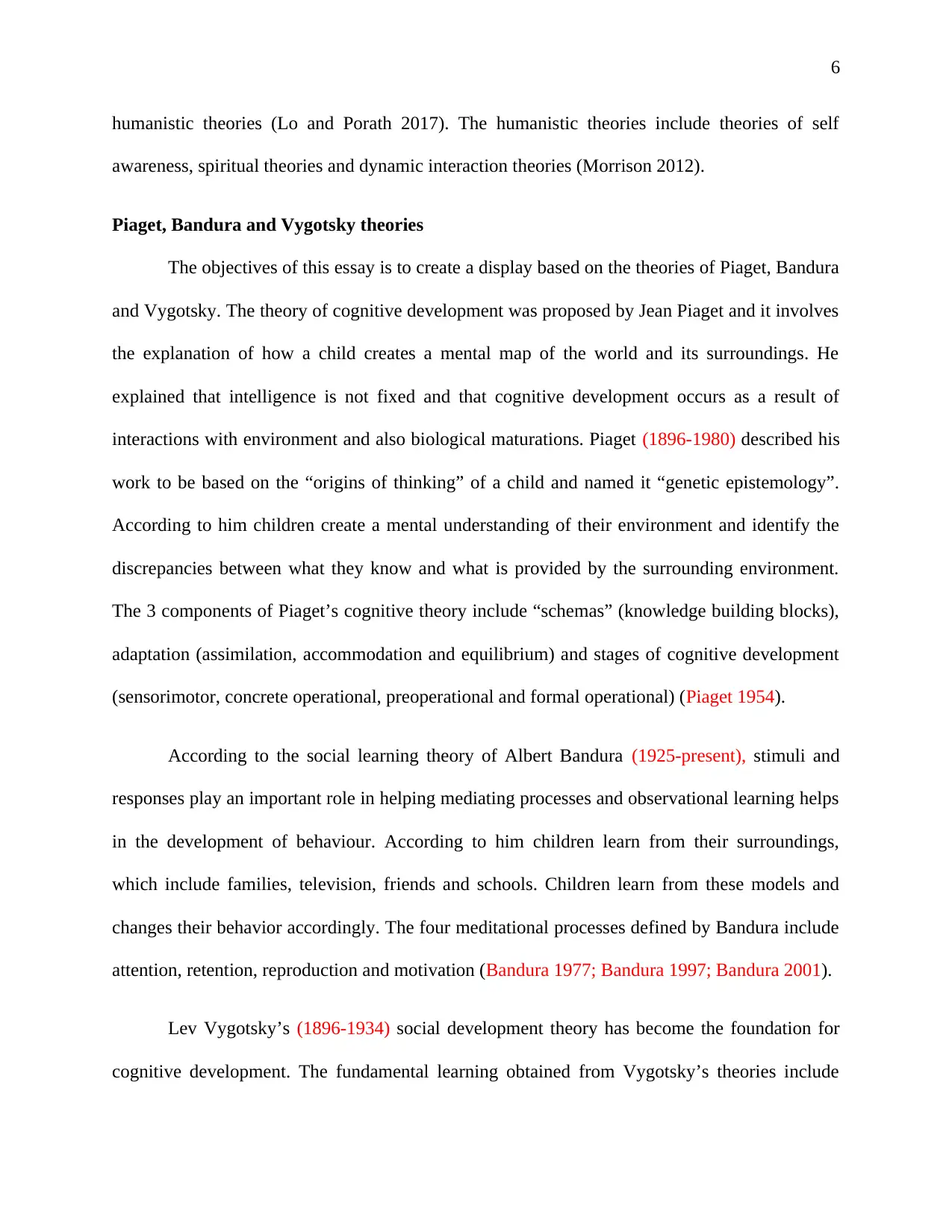
6
humanistic theories (Lo and Porath 2017). The humanistic theories include theories of self
awareness, spiritual theories and dynamic interaction theories (Morrison 2012).
Piaget, Bandura and Vygotsky theories
The objectives of this essay is to create a display based on the theories of Piaget, Bandura
and Vygotsky. The theory of cognitive development was proposed by Jean Piaget and it involves
the explanation of how a child creates a mental map of the world and its surroundings. He
explained that intelligence is not fixed and that cognitive development occurs as a result of
interactions with environment and also biological maturations. Piaget (1896-1980) described his
work to be based on the “origins of thinking” of a child and named it “genetic epistemology”.
According to him children create a mental understanding of their environment and identify the
discrepancies between what they know and what is provided by the surrounding environment.
The 3 components of Piaget’s cognitive theory include “schemas” (knowledge building blocks),
adaptation (assimilation, accommodation and equilibrium) and stages of cognitive development
(sensorimotor, concrete operational, preoperational and formal operational) (Piaget 1954).
According to the social learning theory of Albert Bandura (1925-present), stimuli and
responses play an important role in helping mediating processes and observational learning helps
in the development of behaviour. According to him children learn from their surroundings,
which include families, television, friends and schools. Children learn from these models and
changes their behavior accordingly. The four meditational processes defined by Bandura include
attention, retention, reproduction and motivation (Bandura 1977; Bandura 1997; Bandura 2001).
Lev Vygotsky’s (1896-1934) social development theory has become the foundation for
cognitive development. The fundamental learning obtained from Vygotsky’s theories include
humanistic theories (Lo and Porath 2017). The humanistic theories include theories of self
awareness, spiritual theories and dynamic interaction theories (Morrison 2012).
Piaget, Bandura and Vygotsky theories
The objectives of this essay is to create a display based on the theories of Piaget, Bandura
and Vygotsky. The theory of cognitive development was proposed by Jean Piaget and it involves
the explanation of how a child creates a mental map of the world and its surroundings. He
explained that intelligence is not fixed and that cognitive development occurs as a result of
interactions with environment and also biological maturations. Piaget (1896-1980) described his
work to be based on the “origins of thinking” of a child and named it “genetic epistemology”.
According to him children create a mental understanding of their environment and identify the
discrepancies between what they know and what is provided by the surrounding environment.
The 3 components of Piaget’s cognitive theory include “schemas” (knowledge building blocks),
adaptation (assimilation, accommodation and equilibrium) and stages of cognitive development
(sensorimotor, concrete operational, preoperational and formal operational) (Piaget 1954).
According to the social learning theory of Albert Bandura (1925-present), stimuli and
responses play an important role in helping mediating processes and observational learning helps
in the development of behaviour. According to him children learn from their surroundings,
which include families, television, friends and schools. Children learn from these models and
changes their behavior accordingly. The four meditational processes defined by Bandura include
attention, retention, reproduction and motivation (Bandura 1977; Bandura 1997; Bandura 2001).
Lev Vygotsky’s (1896-1934) social development theory has become the foundation for
cognitive development. The fundamental learning obtained from Vygotsky’s theories include
⊘ This is a preview!⊘
Do you want full access?
Subscribe today to unlock all pages.

Trusted by 1+ million students worldwide
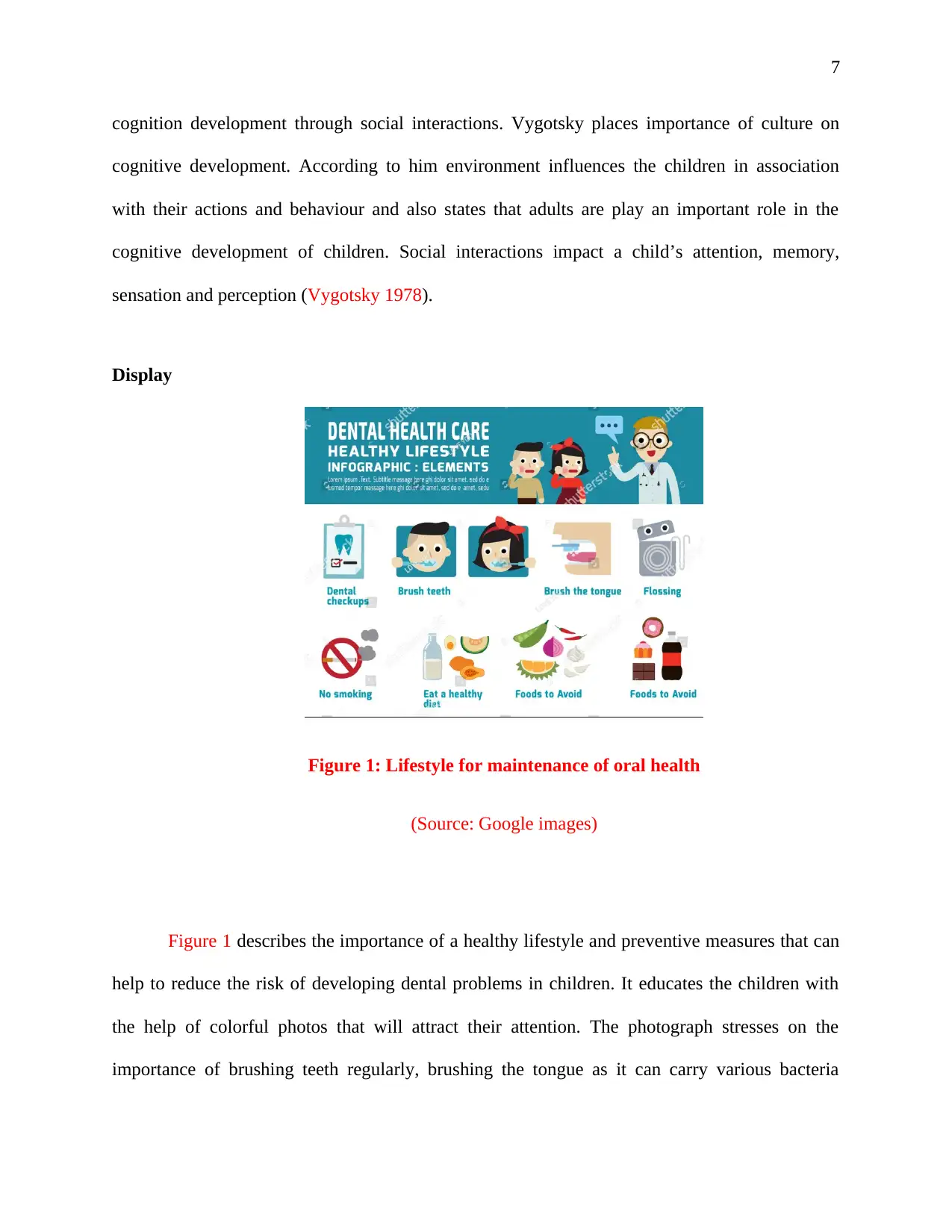
7
cognition development through social interactions. Vygotsky places importance of culture on
cognitive development. According to him environment influences the children in association
with their actions and behaviour and also states that adults are play an important role in the
cognitive development of children. Social interactions impact a child’s attention, memory,
sensation and perception (Vygotsky 1978).
Display
Figure 1: Lifestyle for maintenance of oral health
(Source: Google images)
Figure 1 describes the importance of a healthy lifestyle and preventive measures that can
help to reduce the risk of developing dental problems in children. It educates the children with
the help of colorful photos that will attract their attention. The photograph stresses on the
importance of brushing teeth regularly, brushing the tongue as it can carry various bacteria
cognition development through social interactions. Vygotsky places importance of culture on
cognitive development. According to him environment influences the children in association
with their actions and behaviour and also states that adults are play an important role in the
cognitive development of children. Social interactions impact a child’s attention, memory,
sensation and perception (Vygotsky 1978).
Display
Figure 1: Lifestyle for maintenance of oral health
(Source: Google images)
Figure 1 describes the importance of a healthy lifestyle and preventive measures that can
help to reduce the risk of developing dental problems in children. It educates the children with
the help of colorful photos that will attract their attention. The photograph stresses on the
importance of brushing teeth regularly, brushing the tongue as it can carry various bacteria
Paraphrase This Document
Need a fresh take? Get an instant paraphrase of this document with our AI Paraphraser
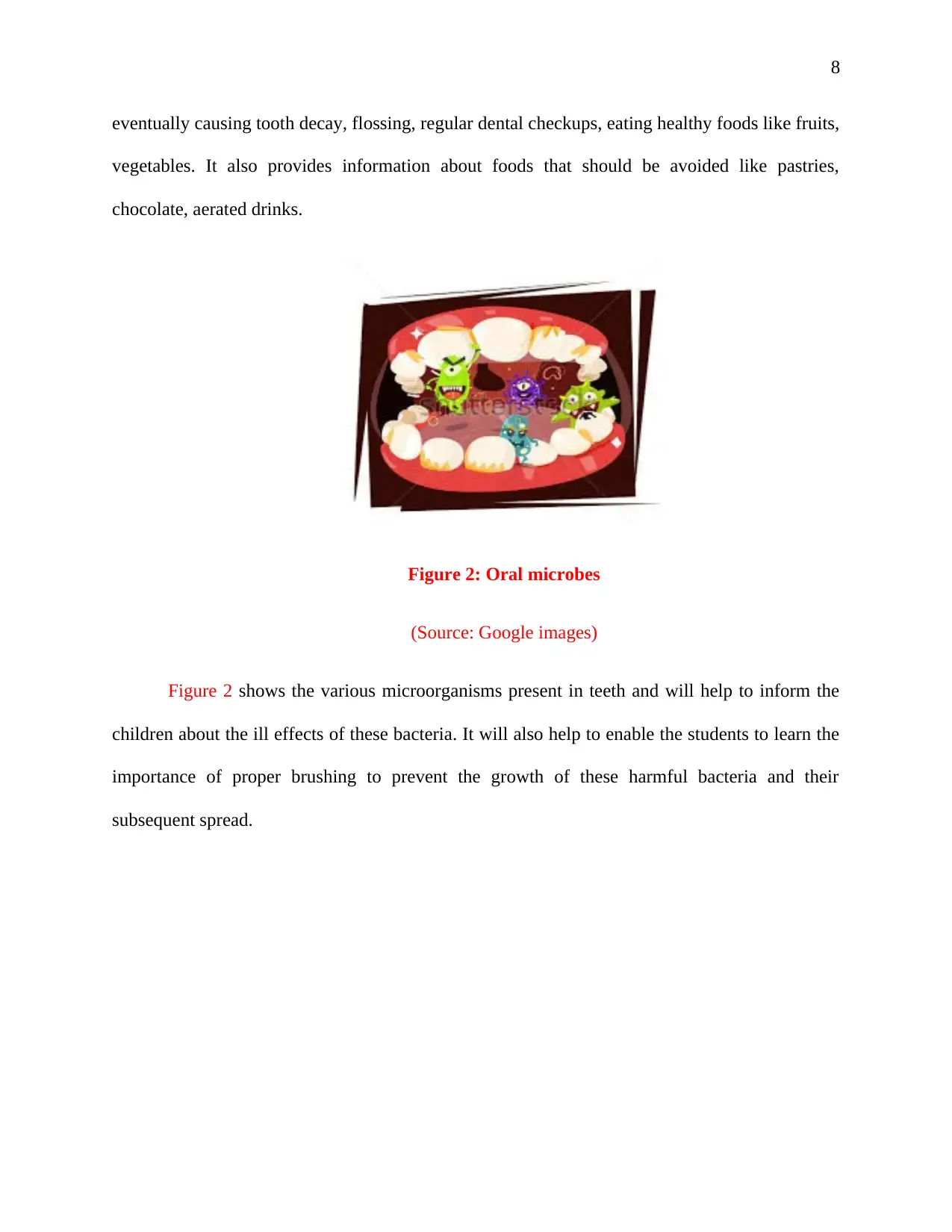
8
eventually causing tooth decay, flossing, regular dental checkups, eating healthy foods like fruits,
vegetables. It also provides information about foods that should be avoided like pastries,
chocolate, aerated drinks.
Figure 2: Oral microbes
(Source: Google images)
Figure 2 shows the various microorganisms present in teeth and will help to inform the
children about the ill effects of these bacteria. It will also help to enable the students to learn the
importance of proper brushing to prevent the growth of these harmful bacteria and their
subsequent spread.
eventually causing tooth decay, flossing, regular dental checkups, eating healthy foods like fruits,
vegetables. It also provides information about foods that should be avoided like pastries,
chocolate, aerated drinks.
Figure 2: Oral microbes
(Source: Google images)
Figure 2 shows the various microorganisms present in teeth and will help to inform the
children about the ill effects of these bacteria. It will also help to enable the students to learn the
importance of proper brushing to prevent the growth of these harmful bacteria and their
subsequent spread.
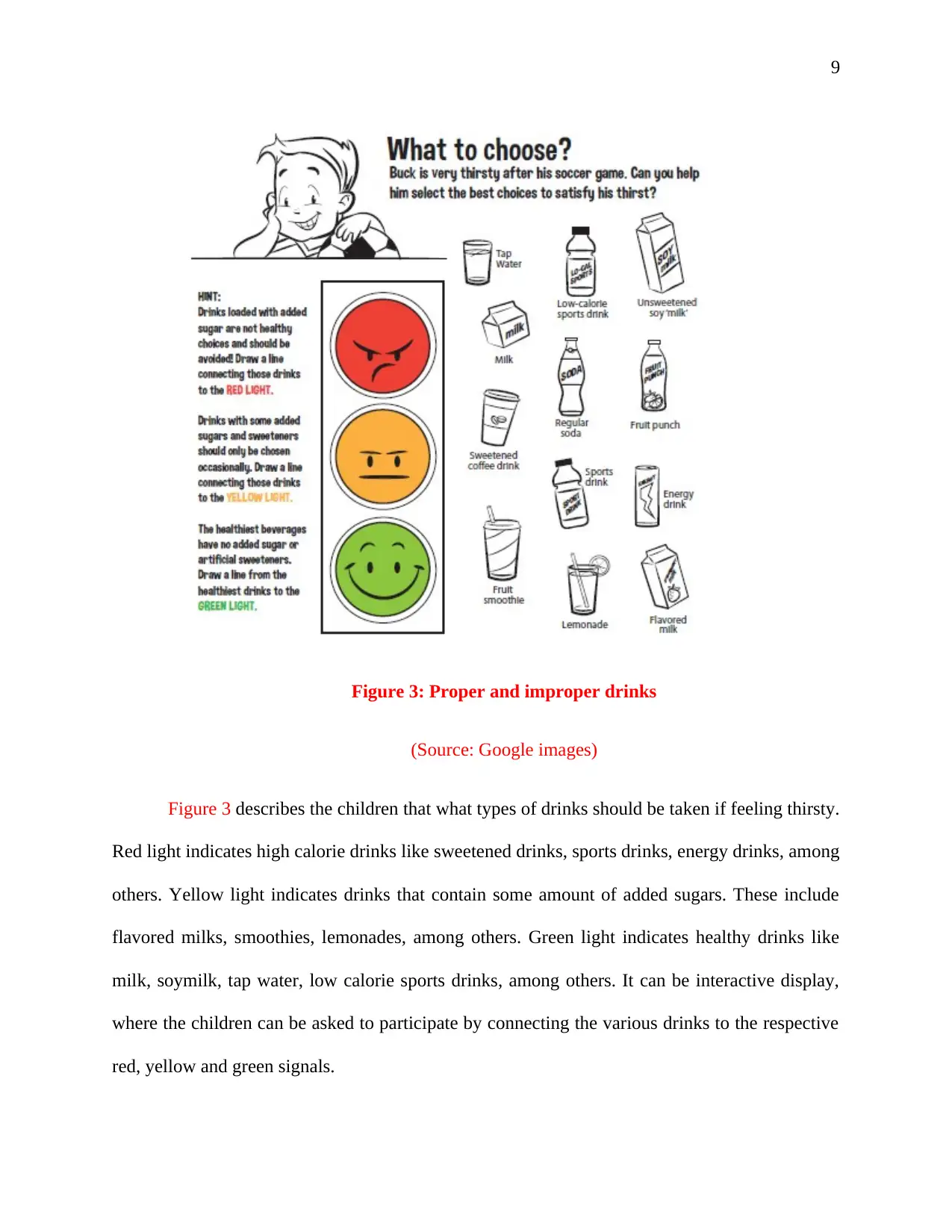
9
Figure 3: Proper and improper drinks
(Source: Google images)
Figure 3 describes the children that what types of drinks should be taken if feeling thirsty.
Red light indicates high calorie drinks like sweetened drinks, sports drinks, energy drinks, among
others. Yellow light indicates drinks that contain some amount of added sugars. These include
flavored milks, smoothies, lemonades, among others. Green light indicates healthy drinks like
milk, soymilk, tap water, low calorie sports drinks, among others. It can be interactive display,
where the children can be asked to participate by connecting the various drinks to the respective
red, yellow and green signals.
Figure 3: Proper and improper drinks
(Source: Google images)
Figure 3 describes the children that what types of drinks should be taken if feeling thirsty.
Red light indicates high calorie drinks like sweetened drinks, sports drinks, energy drinks, among
others. Yellow light indicates drinks that contain some amount of added sugars. These include
flavored milks, smoothies, lemonades, among others. Green light indicates healthy drinks like
milk, soymilk, tap water, low calorie sports drinks, among others. It can be interactive display,
where the children can be asked to participate by connecting the various drinks to the respective
red, yellow and green signals.
⊘ This is a preview!⊘
Do you want full access?
Subscribe today to unlock all pages.

Trusted by 1+ million students worldwide
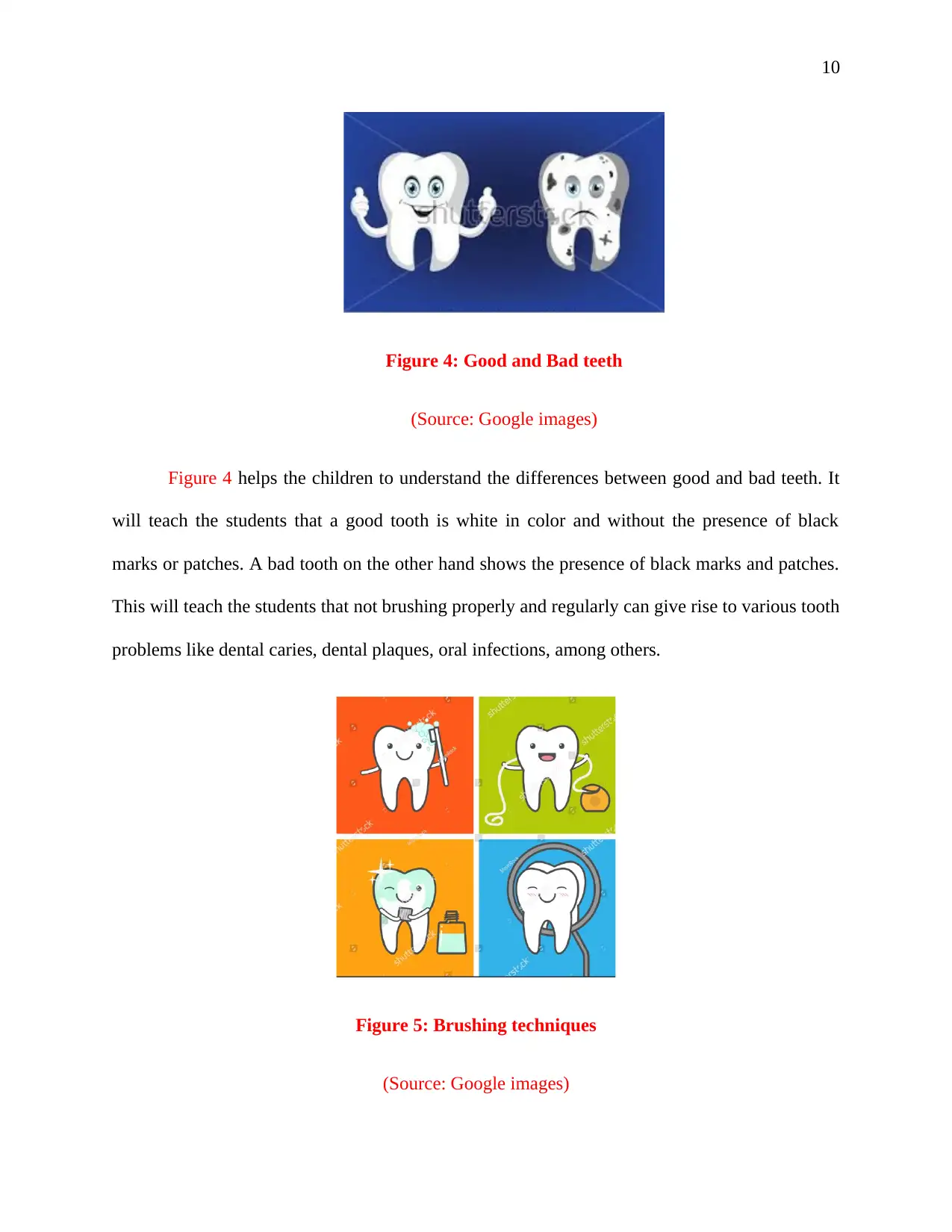
10
Figure 4: Good and Bad teeth
(Source: Google images)
Figure 4 helps the children to understand the differences between good and bad teeth. It
will teach the students that a good tooth is white in color and without the presence of black
marks or patches. A bad tooth on the other hand shows the presence of black marks and patches.
This will teach the students that not brushing properly and regularly can give rise to various tooth
problems like dental caries, dental plaques, oral infections, among others.
Figure 5: Brushing techniques
(Source: Google images)
Figure 4: Good and Bad teeth
(Source: Google images)
Figure 4 helps the children to understand the differences between good and bad teeth. It
will teach the students that a good tooth is white in color and without the presence of black
marks or patches. A bad tooth on the other hand shows the presence of black marks and patches.
This will teach the students that not brushing properly and regularly can give rise to various tooth
problems like dental caries, dental plaques, oral infections, among others.
Figure 5: Brushing techniques
(Source: Google images)
Paraphrase This Document
Need a fresh take? Get an instant paraphrase of this document with our AI Paraphraser
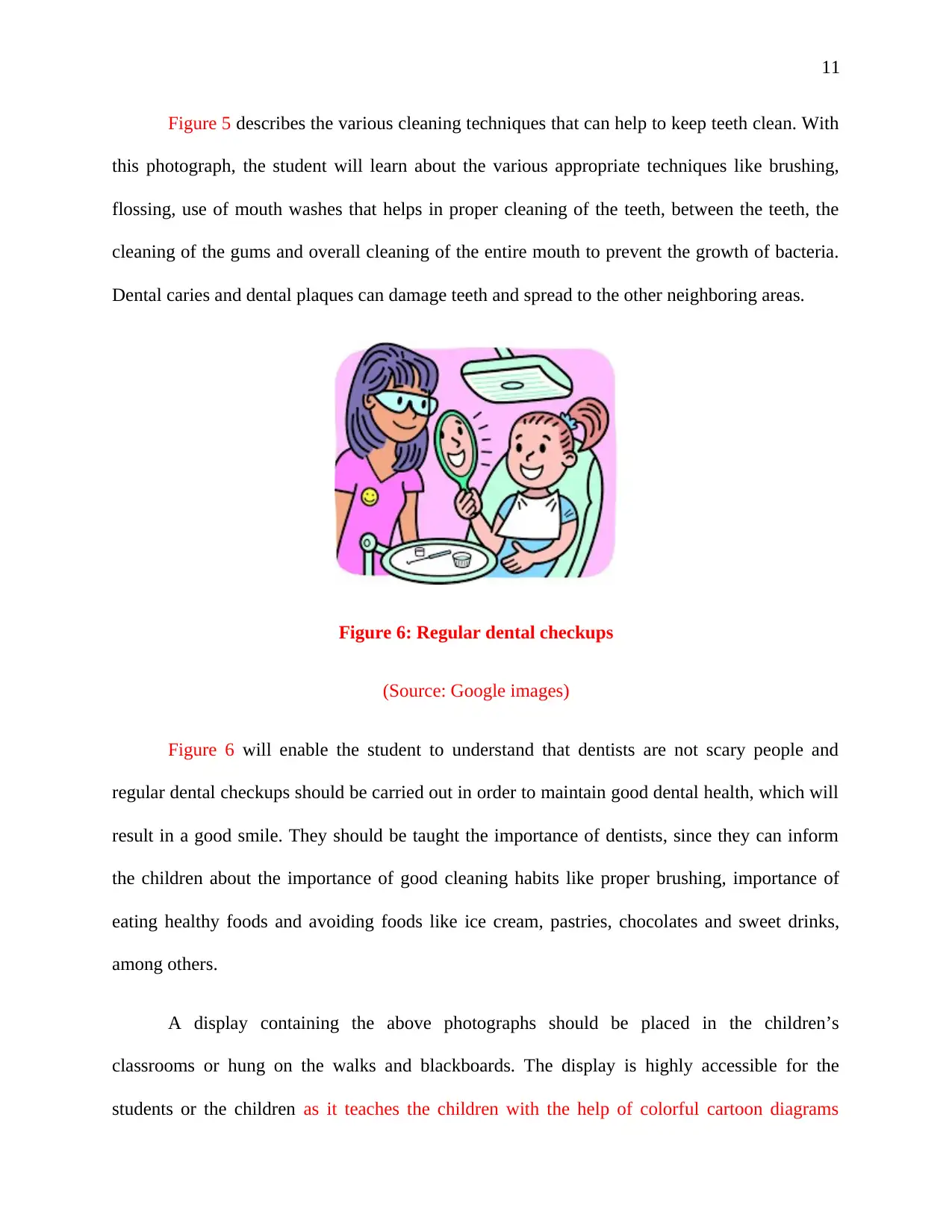
11
Figure 5 describes the various cleaning techniques that can help to keep teeth clean. With
this photograph, the student will learn about the various appropriate techniques like brushing,
flossing, use of mouth washes that helps in proper cleaning of the teeth, between the teeth, the
cleaning of the gums and overall cleaning of the entire mouth to prevent the growth of bacteria.
Dental caries and dental plaques can damage teeth and spread to the other neighboring areas.
Figure 6: Regular dental checkups
(Source: Google images)
Figure 6 will enable the student to understand that dentists are not scary people and
regular dental checkups should be carried out in order to maintain good dental health, which will
result in a good smile. They should be taught the importance of dentists, since they can inform
the children about the importance of good cleaning habits like proper brushing, importance of
eating healthy foods and avoiding foods like ice cream, pastries, chocolates and sweet drinks,
among others.
A display containing the above photographs should be placed in the children’s
classrooms or hung on the walks and blackboards. The display is highly accessible for the
students or the children as it teaches the children with the help of colorful cartoon diagrams
Figure 5 describes the various cleaning techniques that can help to keep teeth clean. With
this photograph, the student will learn about the various appropriate techniques like brushing,
flossing, use of mouth washes that helps in proper cleaning of the teeth, between the teeth, the
cleaning of the gums and overall cleaning of the entire mouth to prevent the growth of bacteria.
Dental caries and dental plaques can damage teeth and spread to the other neighboring areas.
Figure 6: Regular dental checkups
(Source: Google images)
Figure 6 will enable the student to understand that dentists are not scary people and
regular dental checkups should be carried out in order to maintain good dental health, which will
result in a good smile. They should be taught the importance of dentists, since they can inform
the children about the importance of good cleaning habits like proper brushing, importance of
eating healthy foods and avoiding foods like ice cream, pastries, chocolates and sweet drinks,
among others.
A display containing the above photographs should be placed in the children’s
classrooms or hung on the walks and blackboards. The display is highly accessible for the
students or the children as it teaches the children with the help of colorful cartoon diagrams
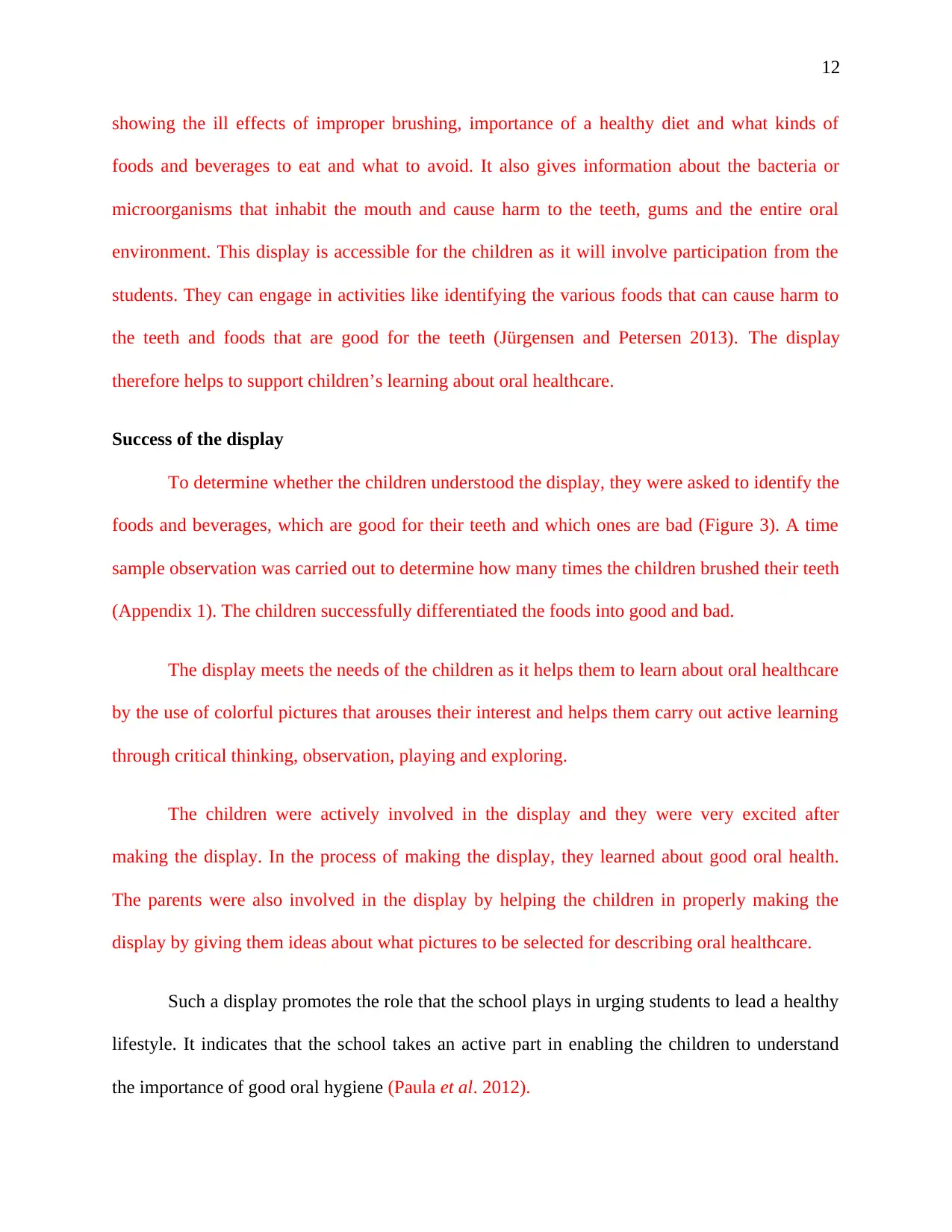
12
showing the ill effects of improper brushing, importance of a healthy diet and what kinds of
foods and beverages to eat and what to avoid. It also gives information about the bacteria or
microorganisms that inhabit the mouth and cause harm to the teeth, gums and the entire oral
environment. This display is accessible for the children as it will involve participation from the
students. They can engage in activities like identifying the various foods that can cause harm to
the teeth and foods that are good for the teeth (Jürgensen and Petersen 2013). The display
therefore helps to support children’s learning about oral healthcare.
Success of the display
To determine whether the children understood the display, they were asked to identify the
foods and beverages, which are good for their teeth and which ones are bad (Figure 3). A time
sample observation was carried out to determine how many times the children brushed their teeth
(Appendix 1). The children successfully differentiated the foods into good and bad.
The display meets the needs of the children as it helps them to learn about oral healthcare
by the use of colorful pictures that arouses their interest and helps them carry out active learning
through critical thinking, observation, playing and exploring.
The children were actively involved in the display and they were very excited after
making the display. In the process of making the display, they learned about good oral health.
The parents were also involved in the display by helping the children in properly making the
display by giving them ideas about what pictures to be selected for describing oral healthcare.
Such a display promotes the role that the school plays in urging students to lead a healthy
lifestyle. It indicates that the school takes an active part in enabling the children to understand
the importance of good oral hygiene (Paula et al. 2012).
showing the ill effects of improper brushing, importance of a healthy diet and what kinds of
foods and beverages to eat and what to avoid. It also gives information about the bacteria or
microorganisms that inhabit the mouth and cause harm to the teeth, gums and the entire oral
environment. This display is accessible for the children as it will involve participation from the
students. They can engage in activities like identifying the various foods that can cause harm to
the teeth and foods that are good for the teeth (Jürgensen and Petersen 2013). The display
therefore helps to support children’s learning about oral healthcare.
Success of the display
To determine whether the children understood the display, they were asked to identify the
foods and beverages, which are good for their teeth and which ones are bad (Figure 3). A time
sample observation was carried out to determine how many times the children brushed their teeth
(Appendix 1). The children successfully differentiated the foods into good and bad.
The display meets the needs of the children as it helps them to learn about oral healthcare
by the use of colorful pictures that arouses their interest and helps them carry out active learning
through critical thinking, observation, playing and exploring.
The children were actively involved in the display and they were very excited after
making the display. In the process of making the display, they learned about good oral health.
The parents were also involved in the display by helping the children in properly making the
display by giving them ideas about what pictures to be selected for describing oral healthcare.
Such a display promotes the role that the school plays in urging students to lead a healthy
lifestyle. It indicates that the school takes an active part in enabling the children to understand
the importance of good oral hygiene (Paula et al. 2012).
⊘ This is a preview!⊘
Do you want full access?
Subscribe today to unlock all pages.

Trusted by 1+ million students worldwide
1 out of 20
Related Documents
Your All-in-One AI-Powered Toolkit for Academic Success.
+13062052269
info@desklib.com
Available 24*7 on WhatsApp / Email
![[object Object]](/_next/static/media/star-bottom.7253800d.svg)
Unlock your academic potential
Copyright © 2020–2025 A2Z Services. All Rights Reserved. Developed and managed by ZUCOL.





